When that furry, fuzzy pet is not safe for you

A feisty parasite is commonly transmitted by cats, who are the natural hosts of the infection. They pick it from eating animals of prey such as mice and rats and then will keep shedding infectious oocysts in their droppings. PHOTO | FOTOSEARCH
Jason* was wheeled into the medical wards in the dead of night, heavily sedated from the emergency department. He was groggy and confused, unsure of where he was, and kept asking for a painkiller.
He was a university student and had been brought in by an ambulance, having suffered a convulsion in the school hostel. No one had any idea what had triggered it in an otherwise healthy young man. However, his roommate remembered that Jason had complained of headaches for the past few days.
We settled Jason in the ward and as his painkillers started to work, he peacefully sank back into sleep. By the time the morning rounds were starting, Jason was already being investigated. Blood, urine and cerebrospinal fluid samples had been taken to the laboratory. He was scheduled for a CT scan of the head later in the course of the morning.
It was agreed by the care team that he would be treated for bacterial meningitis while awaiting a diagnosis from the investigation results. The results started trickling in and they pointed to the most unlikely diagnosis; Jason was suffering from cerebral toxoplasmosis. He was surprised when we broke the news to him. He had no idea how his brain was possibly infected with a cat parasite. He did not own a cat.
PASSION FOR ANIMALS
Another battery of tests was ordered to confirm the toxoplasmosis. Jason did not fit into the classic description of a toxoplasmosis patient. He lived in a hostel that did not permit cats for most of the year and even when he was home for the holiday season, he had no contact with animals. He lived in a flat with his mother, who was allergic to animal fur.
He had undergone preliminary screening for HIV and was negative. Further tests were done to confirm this HIV status, out of caution, and they all came back negative. He had his eyes examined by an ophthalmologist and, luckily, he did not have any toxoplasmosis lesions in his eyes. His chest X-ray was normal and his electrocardiogram showed his heart was functioning normally.
While we were cracking our heads trying to figure out how Jason ended up with toxoplasmosis, he was beginning to respond to the treatment. His seizures were under control and the subtle loss of balance was resolving. He no longer had a headache and was back to his jovial self.
One day, while at the desk outside his room in the ward, I overheard Jason’s friends making fun of him during the visit. They told him how his professor was distraught as there was no one to lovingly care for the lab hamsters and guinea pigs. His friends described how the poor animals were lacking loving care and were dying. A light bulb went off in my head and I joined them with a few questions.
I learnt that Jason was in his fourth year of campus, an avid scientist studying biochemistry in the local university. He was engaged by the university’s work study programme that gave part-time jobs to needy students to earn them some sustenance. Due to his passion for animals, he worked in the laboratory taking care of the experimental animals. This was his source of infection.
Jason was very displeased that we had blamed his furry friends for his diagnosis. He wanted to know why no one else in the lab was sick yet they all worked closely with the animals. Well, he was the one who cleaned up the litter from the cages, a potent source of toxoplasma oocysts.
UNBORN BABY
Despite the fact that toxoplasmosis is more common in patients with a poor immune status, most commonly in HIV, some people with a good immune status are also prone to developing symptoms of the disease. Most immunocompetent people will quickly contain the infection when exposed and will be lifelong carriers, but will never be sick. He was not one of the lucky ones.
This feisty parasite is commonly transmitted by cats, who are the natural hosts of the infection. They pick it from eating animals of prey such as mice and rats and then will keep shedding infectious oocysts in their droppings. These oocysts can remain infectious for up to a year in warm moist environments.
Once they contaminate food and are eaten up by humans, they quickly shed the protective cyst in the intestines and enter the bloodstream and are taken to all other body organs. Where the immune system is unable to contain the infection, it can cause life-threatening lung infections, heart muscle infection, invade the eye and compromise vision or invade the brain, causing abnormal masses like in Jason’s case or cause meningo-encephalitis (inflammation of brain and meninges).
It is also highly dangerous in pregnancy. For the woman who had acquired the infection before pregnancy, there is low risk of transmitting it to the unborn baby. However, for the mother who gets the infection during pregnancy, the risk of infecting her unborn baby is very high, through the placenta or through the birth canal at delivery.
The infection will affect the newborn due to their low immune status, but further, they are highly likely to be left with long-term parasite invasion in the retina of the eye, this will cause recurrent inflammation in the eyes that progressively damages the eyesight. Long-term damage to the central nervous system is also highly likely. This is why pregnant mothers are warned against staying with cats.
Thankfully, when diagnosed in a timely manner, treatment, though prolonged, is highly effective. Treatment in pregnancy is highly challenging, but necessary to avert complications in the baby. To this end, countries with a high prevalence of toxoplasmosis routinely screen the mothers throughout the pregnancy period.
Jason was discharged from hospital with a ton of pills to complete six weeks of treatment and he did well. Trying to reconfigure his relationship with his furry friends was not going to be as easy.
Dr Bosire is an obstetrician/gynaecologist



